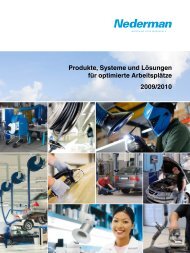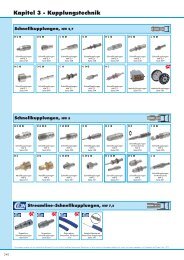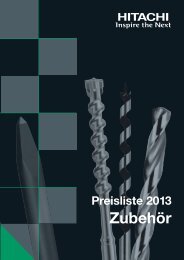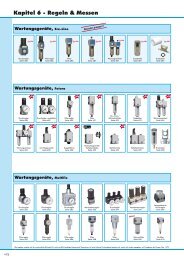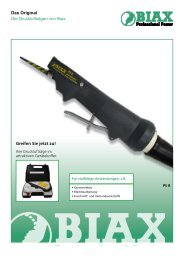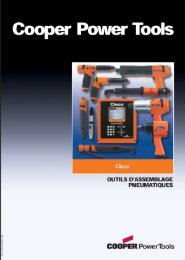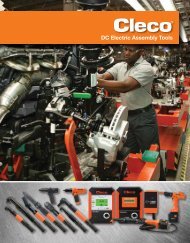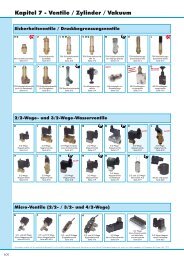AerospaceIndustry - Frank Drucklufttechnik
AerospaceIndustry - Frank Drucklufttechnik
AerospaceIndustry - Frank Drucklufttechnik
Create successful ePaper yourself
Turn your PDF publications into a flip-book with our unique Google optimized e-Paper software.
I-13<br />
Safety Recommendations – Safe Drilling Practices<br />
covered by a clear polycarbonate guard for visibility. The<br />
clamping and feed mechanism can also move when the air<br />
supply is connected or disconnected. To avoid injury, keep<br />
fingers and hands away from these areas when handling or<br />
operating these tools and keep the guard in place.<br />
Before starting the tool, the collet and<br />
mandrel of our Advanced Drilling Equipment<br />
tools must be inserted into a properly sized pre-drilled hole<br />
of proper material thickness. An improperly sized pre-drilled<br />
hole prevents the mandrel from engaging the collet and could<br />
result in slippage of the tool. An improperly selected collet<br />
and mandrel can also result in slippage of the tool.<br />
Repetitive work motions and /or vibration<br />
may cause injury to hands and arms.<br />
Some individuals may be susceptible to disorders of the<br />
hands and arms when performing tasks consisting of highly<br />
repetitive motions and/or exposure to extended vibration.<br />
Cumulative trauma disorders such as carpal tunnel syndrome<br />
and tendonitis can be caused or aggravated by repetitious,<br />
forceful exertions of the hands and arms. Vibration may<br />
contribute to a condition called Raynaud’s Syndrome. These<br />
disorders develop gradually over a period of weeks, months,<br />
and years. It is presently unknown to what extent exposure<br />
to vibrations or repetitive motions may contribute to the<br />
disorders. Hereditary factors, vasculatory or circulatory<br />
problems, exposure to cold and dampness, diet, smoking<br />
and work practices are thought to contribute to the conditions.<br />
Operators should be made aware of the following symptoms<br />
and warning signs so that a problem can be addressed before<br />
it becomes a debilitating injury. Any user suffering prolonged<br />
symptoms of tingling, numbness, blanching of fingers,<br />
clumsiness or weakened grip, nocturnal pain in the hand, or<br />
any other disorders of the shoulders, arms, wrists, or fingers<br />
is advised to consult a physician. If it is determined that the<br />
symptoms are job related or aggravated by movements and<br />
postures dictated by the job design, it may be necessary for<br />
the employer to take steps to prevent further occurrences.<br />
These steps might include, but are not limited to, repositioning<br />
the workpiece or redesigning the workstation, reassigning<br />
workers to other jobs, rotating jobs, changing work pace,<br />
and/or changing the type of tool used so as to minimize<br />
stress on the operator. Some tasks may require more than<br />
one type of tool to obtain the optimum operator/tool/task<br />
relationship.<br />
The following suggestions will help reduce or moderate the<br />
effects of repetitive workmotions and/or extended vibration<br />
exposure:<br />
• Use a minimum hand grip force consistent with proper<br />
control and safe operations.<br />
• Keep body and hands warm and dry (cold weather is<br />
reported to be a major factor contributing to Raynaud’s<br />
Syndrome)<br />
• Avoid anything that inhibits blood circulation<br />
– Smoking Tobacco (another contributing factor)<br />
– Cold Temperatures<br />
– Certain Drugs<br />
• Tasks should be performed in such a manner that the<br />
wrists are maintained in a neutral position, which is not<br />
flexed, hyperextended, or turned side to side<br />
• Stressful postures should be avoided – select a tool<br />
appropriate for the job and work location<br />
• Avoid highly repetitive movements of hands and wrists,<br />
and continuous vibration exposure (aftereach period of<br />
operation, exercise to increase blood circulation)<br />
• Interrupt work, activities, or rotate jobs to provide periods<br />
free from repetitive work motions<br />
• Keep tool well maintained and replace worn parts<br />
Speed and Feed Selection Considerations<br />
Because our Advanced Drilling Equipment tools are portable<br />
and generally hand-carried from one drill location to the next,<br />
every effort has been made to make them as compact and<br />
light-weight as possible without compromising the strength<br />
required to provide rugged durability and service. A wide<br />
selection of feeds and speeds are available to accommodate<br />
drilling of a variety of materials.<br />
Good machining practice is an integral part<br />
of obtaining optimum service life from the<br />
tool and the cutter. Selection of speeds and feeds must take<br />
into consideration workpiece material and hardness, cutter<br />
geometry and sharpness, and quality of lubrication.<br />
Use of the highest feed rates at the lowest speeds in conjunction<br />
with very tough or hard materials will likely result in<br />
higher than normal maintenance. The exceptionally low<br />
speeds, obtained by high numerical gear reductions, can<br />
yield very high theoretical stall torque that far exceed the<br />
torque requirements of a well engineered drilling application.<br />
High loads imposed by feeds excessive for the material and<br />
cutter combination may result in damage.<br />
TORQUE CONVERSION – IN. LBS. (NM)<br />
In. Nm In. Nm In. Nm<br />
5 0.6 50 5.7 140 15.8<br />
10 1.1 60 6.8 150 17.0<br />
15 1.7 70 7.9 160 18.1<br />
20 2.3 80 9.0 170 19.2<br />
25 2.8 90 10.2 180 20.3<br />
30 3.4 100 11.3 190 21.5<br />
35 4.0 110 12.4 200 22.6<br />
40 4.5 120 13.6<br />
45 5.1 130 14.7<br />
Suggested Surface Speeds<br />
for High Speed Steel Drills*<br />
MATERIAL S.F.M.<br />
Alloy Steels – 300 to 4000 Brinell 20-30<br />
Stainless Steels – Medium range 30-40<br />
Automotive Steel Forgings and the like 40-50<br />
Tool Steels Annealed – 90 to 1.20 Carbon 50-60<br />
Steels – .40 to .50 Carbon 70-80<br />
Steels – .20 to .30 Carbon (Machinery Steel) 80-110<br />
Hard, Chilled Cast Iron 30-40<br />
Medium Hard Cast Iron 70-110<br />
Soft Cast Iron 100-150<br />
Malleable Iron 80-90<br />
Monel Metal 40-50<br />
High Tensile Strength Bronze 70-150<br />
Ordinary Brass and Bronze 200-300<br />
Aluminum and its Common Alloys 250-400<br />
Magnesium and its Common Alloys 250-400<br />
Plastics – Common Types 100-150<br />
Wood 300-400<br />
* Carbon Steel Drills should be operated at 40%–50% of the<br />
above speeds.<br />
These speeds indicate the approximate range under normal conditions.<br />
For peak performance on individual jobs, adjustments may be required.<br />
To convert surface feet per minute (SFM) into revolutions per minutes<br />
(RPM) use the following formula:<br />
SFM x 3.82<br />
RPM =<br />
Diameter<br />
Example: To drill 1/4" hole in aluminum:<br />
300 x 3.82<br />
= 4.584 RPM<br />
.250<br />
Recommended Tool: Cleco 111 DO-50B<br />
Conversion Table<br />
Torque – Air Pressure – Miscellaneous<br />
To Convert<br />
TORQUE CONVERSION FACTORS<br />
Into Mulitply By<br />
Inch Pounds Foot Pounds 0.0835<br />
Inch Pounds Newton meters 0.1130<br />
Inch Pounds Kg-meters 0.0115<br />
Inch Pounds Kg-Cm 1.1519<br />
Foot Pounds Inch Pounds 12.000<br />
Foot Pounds Newton meters 1.3560<br />
Foot Pounds Kg-meters 0.1382<br />
Foot Pounds Kg-Cm 13.8240<br />
Newton Meters Inch Pounds 8.8440<br />
Newton Meters Foot Pounds 0.7370<br />
Newton Meters Kg-meters 0.1020<br />
Newton Meters Kg-Cm 10.2000<br />
Kg meters Inch Pounds 86.8100<br />
Kg meters Foot Pounds 7.2340<br />
Kg meters Newton-meters 9.8040<br />
Kg Cm Inch Pounds 0.8681<br />
Kg Cm Foot Pounds 0.0723<br />
Kg Cm Newton-meters 0.0980<br />
MISCELLANEOUS CONVERSION FACTORS<br />
To Convert Into Mulitply By<br />
Inches Millimeters 25.4000<br />
Millimeters Inches 0.0394<br />
Pounds Kilograms 0.4536<br />
Kilograms Pounds 2.2050<br />
psi bar 0.069<br />
bar psi 14.5<br />
PSI<br />
AIR PRESSURE CONVERSION<br />
kPa* Bar**<br />
85 586 5.9<br />
90 620 6.2<br />
95 655 6.6<br />
100 690 6.9<br />
125 860 8.6<br />
* Preferred: Approximate to the nearest 5 kPa.<br />
** Approximate to the nearest 0.5 Bar.<br />
Drill Diameter<br />
Surface Speed, Feet per Minute<br />
(inches)<br />
30 40 50 60 70 80 90 100 110 200 300 400<br />
Spindle Speeds, RPM<br />
1/4 458 611 764 917 1070 1222 1375 1528 1681 3056 4584 6111<br />
5/16 367 489 611 733 856 976 1100 1222 1345 2445 3666 4888<br />
3/8 306 407 509 611 713 815 917 1019 1120 2037 3056 4074<br />
7/16 262 349 437 524 611 698 786 873 960 1746 2619 3492<br />
1/2 229 306 382 458 535 611 688 764 840 1528 2282 3056<br />
If there is a choice between tools of about the same speed but of different sizes, final selection is made by preference for a lighter-weight tool or one with more<br />
power to maintain speed under load.<br />
I-14




